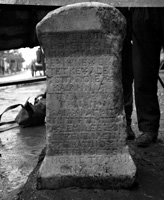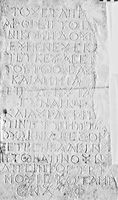 MAMA XI 38 (Eumeneia)
MAMA XI 38 (Eumeneia) 
Funerary bomos of Aur. Threptos and family
- Type of monument:
- Funerary bomos.
- Location:
- Çivril (Eumeneia): outside the Güneş Kahvesi, near the centre of town.
- Description:
- Coarse marble bomos, complete.
- Dimensions:
- Ht. 0.74; W. 0.34 (upper moulding), 0.28-0.32 (shaft), 0.39 (lower moulding); Th. 0.32 (upper moulding), 0.26-0.28 (shaft), 0.36 (lower moulding); letters 0.020-0.030.
- Record:
- Squeeze; WMC notebook copy; photograph (1954/17).
- Publication:
- None.
- Date:
- AD 253/4 (Year 338 of Sullan era).
ἔτους τλη´, μη(νὸς) [- - -]
Α⟨ὐ⟩ρ(ήλιος) Θρέπτος
Νικομήδους
Εὐμενεὺς κα̣-
5τε⟨σ⟩κεύασεν̣
τὸ ἡρῷον ἑαυ[τῷ]
καὶ Ἀμμίᾳ
τῇ γλυκυτάτ̣[ῃ]
γυναικὶ
10καὶ Αὐρ(ηλία) Ἀγριπ-
πίνῃ τῇ μητρ[ὶ]·
οὐδενὶ δὲ ἐξὸν
ἔστε ἐνβαλεῖν
πτῶμα· ἢν οὖν,
15δ⟨ώ⟩σι προστεί-
μου ἰς τὸ ταμῖ-
ον (δηνάρια) ͵αφ´
Line 5: ΤΕΤΚΕΥΑΣΕΝ̣ lapis.
Line 15: ΔΠΣΙ lapis.
Year 338, Month [-]. Aur. Threptos, son of Nikomedes, citizen of Eumeneia, constructed the tomb for himself and for Ammia, his sweetest wife, and for Aur. Agrippina, his mother. It will not be permitted for anyone to inter a dead body; if (anyone) does so, he will pay a fine to the treasury of 1,500 denarii.





The mason was illiterate; aside from the two errors indicated above, pi is used in place of eta throughout the inscription (lines 1, 3, 8, 11, 14, 15). In line 1, there is space for only a single letter (i.e. a numeral) at the end of the line; for the numbering of months at Eumeneia, cf. SEG 28, 1129; MAMA XI 36 (1954/14); MAMA XI 35 (Barnett 1954/2).
In line 4, Threptos describes himself as Εὐμενεύς, ‘citizen of Eumeneia’. That Εὐμενεύς was the normal ethnic of Eumeneia is correctly stated by Stephanos of Byzantion, s.v. Εὐμένεια; this is the only form of the ethnic to be attested on the inscriptions and coinage of Eumeneia. However, the Flavian conventus-list from Ephesos gives the ethnic of the city as Εὐμενέται (I.Ephesos 13.II 30), and the ethnic Εὐμενεάτης is attested both at Athens (IG II2 8503a, Addenda p. 884) and Daldis (TAM V 1, 635). The normal female version of the ethnic seems to have been Εὐμενεῖτις: thus MAMA IV 360 (Αὐρηλία Τάτιον Εὐμενεῖτις) and Ramsay, Phrygia II 390, no. 249 (read by R. as Ἰουλία Μητρο|δώρου Εὐμενε|τίς; we should certainly restore the ethnic here as Εὐμενε[ῖ]|τις). However, the form Εὐμένισσα is also twice attested for female citizens of Eumeneia, once at Athens (IG II2 8503) and once at Rome (IGUR II 902). On this variation, see further Robert, Hellenica II, 83-4.
It is a curious feature of the funerary epigraphy of Eumeneia that it seems to have been normal practice for citizens of Eumeneia to use the city-ethnic Εὐμενεύς on their tombstones. In a few cases the ethnic is combined with the word βουλευτής, ‘councillor, decurion’ (cf. MAMA XI 45 (1954/13)): thus e.g. (1) Buckler, Calder and Cox 1926: 69-70, no. 194 (Ramsay, Phrygia II 525, no. 368: Αὐρ. Ζωτικὸς... Εὐμενεὺς βουλευτής); (2) Ramsay, Phrygia II 519, no. 359 (Αὐρ. Ἀλέξανρος... Εὐμενεὺς βουλευτής); (3) Drew-Bear 1978: IV 33 (SEG 28, 1165: Π. Αἴλ. Παυλεῖνος Εὐμενεὺς βουλευτής). Compare also, in neighbouring cities, Ramsay, Phrygia II 658, no. 605 (provenance Akmoneia: [Αὐρ.] Φιλόδ[η]μος Ἀντω[νει]νιανὸς Δομν[ι]ανὸς Εὐμενεὺς βουλευτής); Buckler, Calder and Cox 1926: 87-8, no. 217 (provenance Sebaste: Μ. Αὐρ. [Πα]σικλέους... Εὐ[με]νέως [β]ουλευτοῦ). It seems likely that in such cases the ethnic Εὐμενεύς should be read as qualifying the noun βουλευτής, ‘councillor of the Eumeneian boule’ (Thonemann 2007: 457); indeed, this sense is explicit in two inscriptions from Eumeneia: (1) Ramsay, Phrygia II 380, no. 210 (Γάιος Ἰούλιος Μυρτίλος [οὐ]ετρανὸς βουλευτὴς τῆς Εὐμενέων πόλεως); (2) Ramsay, Phrygia II 383, no. 219 ([Ἀλέξα]νδ[ρ]ος β΄ [βουλευτὴς Εὐ]μενέων). In two further cases, the ethnic is used to indicate multiple citizenship: Buckler, Calder and Cox 1926: 80-2, no. 204 (Ramsay, Phrygia II 522, no. 364: Αὐρ. Εὐτύχης... ἐπίκλην Ἕλιξ Εὐμενεὺς καὶ ἄλων πόλεων πολείτης); Ramsay, Phrygia II 389, no. 238 (Ἑρμῆς Ἀκμονεὺς καὶ Εὐμενεύς).
It is true that in the Roman imperial period, the local ethnic was often used within a city’s own territory: BE 1959, 434; BE 1965, 253; BE 1974, 330, 458; BE 1976, 567; Drew-Bear 1978: 105. However, Eumeneia appears to be the only city of southern Phrygia in which the ethnic was regularly used in the city’s funerary epigraphy; I know no examples of Ἀπαμεύς in the funerary epigraphy of Apameia-Kelainai, and only a single example of Σεβαστηνός at Sebaste (Ramsay, Phrygia II 560, no. 451). It is possible that the large foreign military presence at Eumeneia (cf. MAMA XI 33 (1954/5), 28 (1954/12), 65 (1954/25)) rendered it desirable for local citizens to distinguish themselves as such on their tombstones.